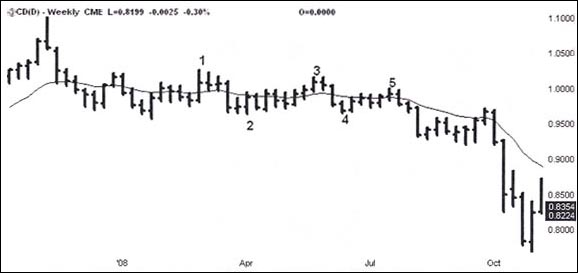
Symmetrical Triangles
By: Andy Chambers
The following is an excerpt from Andy Chambers' RI5 System
Symmetrical triangles are great patterns to trade. A symmetrical triangle is a continuation pattern that narrows until it finally erupts in a breakout. The best patterns have five legs, and each leg is smaller than the preceding leg. A move beyond the leg 4 high or low suggests that the market is ready for a breakout. Since it’s a continuation pattern, we expect the market to break out of the triangle the same way it came in. This symmetrical triangle in the Canadian Dollar resulted in a major breakout. The triangle took a long time to form. The longer a market goes sideways, the bigger the breakout can be. We can estimate a target for the pattern by measuring the width of the first leg and adding that to the leg 4 high, if the pattern is bullish, or subtracting it from the leg 4 low, if the pattern is bearish.

No matter what tools and methods you use, there will be plenty of lessons to learn along the way. Here are some things to keep in mind:
- Don’t mix up your time frames. If your trade is based on a daily setup, don’t pay too much attention to the intraday charts. Intraday swings are more frequent and they can cause you to exit too early. Likewise, if the trade is based on a weekly chart, don’t pay too much attention to the daily chart. As a wise man once said, “Too much attention to price fluctuation all but guarantees financial suicide.” We need to define a trading plan and have the discipline to stick with it.
- Diversify. No matter how strong the trend is, it isn’t a good idea to put all your money in one market or one complex.
- Manage your money. Many of the top pros limit their risk to one or two percent of the account balance.
- If you’re buying options, buy time. The biggest problem with options is time decay. The more time you buy, the less you pay per day and the more you minimize the effect of time decay.
- Have reasonable expectations. I once talked to a novice trader who lost his job and hoped to replace his income by making $50,000 a year on a $10,000 account. That’s a lot to ask in any case, but if you add the pressure of trying to replace your regular income, the stress alone can beat you. Warren Buffet is one of the richest men in the world. I’ve read that his compounded annual rate of return for over thirty years is just under 25%.
- You can’t win if you’re afraid to lose. Being afraid to lose can cause you to sabotage your trading. As a rule, risk about half as much as you think you can handle. The less you risk, the less afraid you’re likely to be, and the more likely you are to follow your plan.
- If you catch a good move, be patient with your profit exit. Let your profits run, or hedge them with options. Jesse Livermore said, “After spending many years in Wall Street and after making and losing millions of dollars I want to tell you this: It never was my thinking that made the money for me. It always was my sitting. Got that? My sitting tight.”
- You don’t need to trade often to trade well. Be patient. Wait for the best setups.
In my opinion:
- The most important part of the trade is knowing where you’re wrong.
- The most important action is cutting losses.
- The easiest step in the trading process is getting in.
- The hardest part is letting profits run.
- The keys to success are consistency and money management.
A successful trading plan essentially boils down to this:
- Know what will trigger your entry.
- Know what will cause you to close the position with a loss.
- Know what will prompt you to take profits.
- Last, but not least, we must have rules regarding money management.